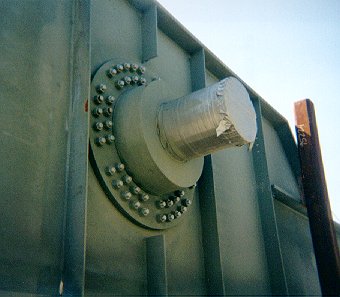DESIGN OF TRUNNION-HUB GIRDER ASSEMBLIES FOR BASCULE BRIDGES
Committed to bringing numerical methods to undergraduates

Home | Grant 1: (98-01) | Grant 2: (01-03) | Grant 3: (04-05) | Pictures | Links
|
DESIGN OF TRUNNION-HUB GIRDER ASSEMBLIES FOR BASCULE BRIDGES Committed to bringing numerical methods to undergraduates |
|
|
|
|
||
|
Home | Grant 1: (98-01) | Grant 2: (01-03) | Grant 3: (04-05) | Pictures | Links |
||
Grant 3: Hub Assemblies for the next generation of bascule bridges Bascule bridge designs used in Florida are evolving rapidly as their size increases to handle the increased traffic demands. Examples of recent bridges that represent the next generation of design include the 17th Street Causeway Replacement Bridge in Broward County, 12th Avenue Replacement Bridge and 2nd Avenue Bridge (both in Miami-Dade County).
Design of such large bascule bridges capable of handling up to four lanes of traffic (and possibly six in the future) brings new challenges that have not been addressed by current design guidelines. For example, the 17th Street Causeway Bridge utilizes a box girder design for the main girders instead of the commonly found plate girders, and simple trunnion or Hopkins frame designs of the past. Also, 2nd Avenue is an enormous bridge with nearly 4 foot diameter trunnions.
Assembly requirements of such designs place constraints on the hub size as well as the type of joint utilized by such hub assemblies. As a result, many of these bridges deviate from current AASHTO and FDOT guidelines on hub geometry as well as hub assembly designs (such as eliminating the shrink fit between the hub and the girder).
In light of these recent developments and the direction new bascule bridge designs are headed, it is essential to study the impact of deviation from existing requirements on the performance of bridges, with the aim of updating them to provide designers with guidelines for designing the next generation of bascule bridges. Specific items that need to be addressed include hub-geometry requirements, where it is widely believed that existing guidelines are no longer suitable due to the significant changes in bascule bridge designs as they have evolved from using massive gears to hydraulic systems. In addition, the impact of the hub geometry on the assembly process must also be addressed since several hubs were found to fail during the hub-girder shrink fitting procedure. |
| | Mechanical | USF | FDOT | E-mail |
 |